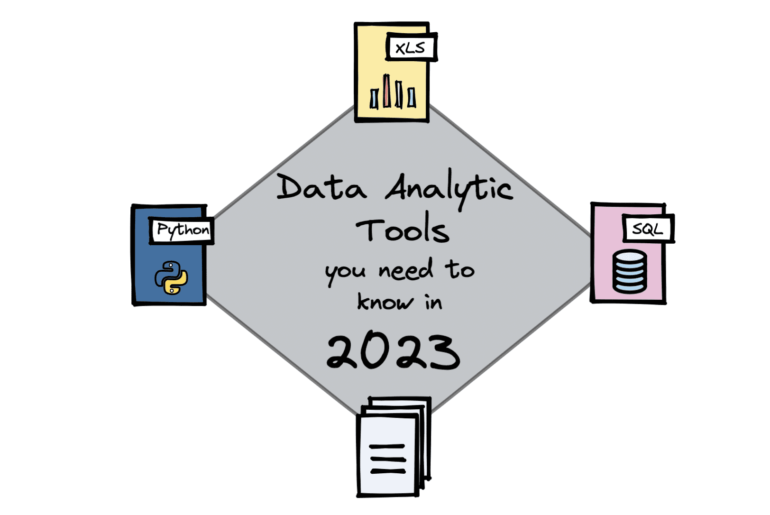By Nisha Arya
What tools do you need to know to be a successful data analyst?
You may want to transition into data analytics, or it could be a completely new field for you. Regardless, being prepared is always crucial. The majority of people who enter a new career are looking at the end goal: getting a job. However, some are so focused on landing their dream job: they forget that they need to be proficient in the required skills and tools.
What is a Data Analyst?
A Data Analyst is someone who looks through data and provides reports and visualisations which explain the data.
A data analyst does not typically spend their day coding. Their responsibilities involve using their technical mindset along with their excel, coding, or SQL skills to identify trends, patterns and solutions that can aid a business’s decision-making process. They are also responsible for turning these findings into visualisations to present to stakeholders.
Now let’s get into the must-have tools that a data analyst needs to be successful in their job.
What tools do you need to know as a Data Analyst?
Excel
- Type of tool: Spreadsheet software.
- Availability: Commercial.
- Use: Data wrangling and reporting.
Excel has been frequently used by many people from different industries – it is a staple in most fields. If you remember in school, you probably used it but didn’t realise its full capabilities. Apart from sorting and organising data, it also has calculation and graphing functions which are very ideal for data analysis.
Although Excel is popular and uses a lot of useful functions and plug-ins. It also comes with its downfalls. Due to its capabilities and processing power, it runs very slowly when dealing with big datasets and can lead to calculation errors and inaccuracies.
Python
- Type of tool: Programming language.
- Availability: Open-source.
- Use: Developing websites/software, task automation, data analysis, and data visualization
Python is a general-purpose programming language known for its simple syntax making it easy to learn a programming language. It is currently the most popular programming language due to its intuitive syntax. It contains a variety of libraries, such as NumPy to help process computational tasks.
As a Data Analyst, you can use Python to help with your data analysis, such as importing and filtering data, statistical tests, finding correlations between the data and producing visualization.
R
- Type of tool: Programming language.
- Availability: Open-source.
- Use: Statistical analysis and data mining.
A lot of people have trouble choosing which programming language to learn – Python or R. Python is known for being a general-purpose programming language, whereas R is a statistical programming language.
The syntax for R is more complicated in comparison to Python, but this is due to it being built specifically to handle heavy statistical computing tasks and create data visualizations.
SQL
- Type of tool: Standardized programming language.
- Availability: Commercial.
- Use: Communicate with a database
As a Data Analyst, you will spend a lot of time communicating with databases. It is used to perform tasks such as updating data on a database or retrieving data from a database. It provides you with a simpler way to scan through your database and explore new findings with a few lines of code.
Jupyter Notebook
- Type of tool: Interactive authoring software.
- Availability: Open-source.
- Use: creating and sharing code/computational documents.
Jupyter Notebook is an open-source software which provides interactive computing and is compatible across different programming languages. It can create and share documents that contain live code, equations, visualizations, and text between members of the team.
Its top uses are programming practice, collaboration across projects, data cleaning, data visualisation, and sharing. It also integrates with big data analysis tools such as Apache Spark, which we will speak about next.
Apache Spark
- Type of tool: Data processing framework.
- Availability: Open-source.
- Use: Big data workloads.
Apache Spark is an analytics engine that can process large-scale data, quickly and effectively. It is known that Apache Spark can help you run your workloads 100 times faster. As a Data Analyst, you will use it to process various datasets and analyze unstructured big data, along with machine learning.
The framework is compatible with programming languages such as Python, R, Java, Scala, and SQL.
Tableau
- Type of tool: Data visualization tool.
- Availability: Commercial.
- Use: Connect data, and build workbooks, stories, and dashboards.
Tableau is one of the market-leading business intelligence tools which is used to analyze and visualize data in an easy format. If you are a data analyst that doesn’t have proficient coding skills but you still want to be able to create interactive visualizations and dashboards to present to stakeholders, Tableau is here to save you.
It contains features such as machine learning, statistics, natural language, and smart data prep. It has not only made life easier for data scientists, but also for business users.
SAS
- Type of tool: Statistical software suite.
- Availability: Commercial.
- Use: statistical analysis and data visualization.
SAS is a command-driven software, only for Windows operating systems. It stands for Statistical Analysis System and is a group of programs that work collectively to store and retrieve data, be able to modify it, compute statistical analyses, and create visualisations and reports.
The software helps you to gain quick insights into your data, in which you can then use automated analysis which is backed by machine learning, to then produce reports that are easy to understand for the decision-making process.
KNIME
- Type of tool: Data integration platform.
- Availability: Open-source.
- Use: access, blend, analyze, and visualize data
KNIME is an open-source software, that allows you to build analyses at any complexity level. You can either use the:
- KNIME Analytics Platform – to clean and gather your data, analyze it and make it accessible to everyone using visualisations.
- KNIME Server – the deployment of workflows, whilst making them accessible to the team for collaboration, management, and automation.
Microsoft Power BI
- Type of tool: Business analytics suite.
- Availability: Commercial.
- Use: Transform data into visually immersive, and interactive insights
Microsoft Power BI allows you to take your data and create interactive visual reports and dashboards to share your findings more comfortably. It operates with Excel, text files, SQL, and cloud sources. Your data is safe with Power BI as it uses sensitivity labelling, end-to-end encryption, and real-time access monitoring.
You have a choice between their range of products such as Power BI Desktop, Power BI Pro, Power BI Premium, Power BI Mobile, Power BI Embedded, and Power BI Report Server.
Conclusion
As you continue your journey as a data analyst, you will see these current tools advance and new tools emerge in the market. Your skillset is dependent on where you want to be in the next 10 years. The more you know, the better.
If you are still unsure about the path to data analysis and need more guidance, have a read of:
Feature Image Credit: Author
By Nisha Arya
Nisha Arya is a Data Scientist, Freelance Technical Writer and Community Manager at KDnuggets. She is particularly interested in providing Data Science career advice or tutorials and theory based knowledge around Data Science. She also wishes to explore the different ways Artificial Intelligence is/can benefit the longevity of human life. A keen learner, seeking to broaden her tech knowledge and writing skills, whilst helping guide others.


